Everything New in DriveWorks 21: Rules, Integration, 3D Previews & More
DriveWorks 21 is shaping up to be perhaps the best release yet. Introduced at DriveWorks World 2023, DriveWorks 21 is more intuitive, more cloud-ready, and more customizable than ever before. Some of the biggest changes provide DriveWorks Live users with more reliable, modern methods of web integration. These enhancements provide a seamless transition between the Administrator tool and the embedded website configurator.
DriveWorks Live Users
DriveWorks Live users who rely on the Web Theme or Application Theme should consider delaying their upgrade until DriveWorks 21 SP1. Those themes are
not
part of this first release of the latest version and upgrading without them could cause problems in your production environment. As an alternative, the
DriveWorks Live Integration Theme
offers another way to integrate your DriveWorks project directly into an HTML page, without the need for an iFrame. If, however, you are set on keeping the Web or Application Themes, we encourage you to wait until the first service pack is released.
This article provides a high-level overview of what to expect in several of the core functions within DriveWorks, including enhancements to:
- Design Automation – Drive more model features to maximize your automation ability.
- CPQ – Work more efficiently, with more customization and ease-of-use enhancements.
- Workflow – Enhancements include a more intuitive UI.
- Rules – Optimize performance while offering more customizability.
- Integration – Access and optimize your Cloud environments and manage data through the 3DEXPERIENCE Platform.
- Documents – Manage and edit PDF documents with ease.
- Forms - Now supports modern web solutions for front-end web development.
- 3D Previews – Significantly increased quality, ease of use, and performance of 3D preview models.
If you have an active subscription and can upgrade to the latest release of DriveWorks, let us walk you through why it just might change the entire trajectory of your project.
Design Automation
DriveWorks 21 includes some new advanced feature parameters for driving sheet metal components.
Without advanced feature parameters, the only parameters we can drive in a SOLIDWORKS model are the feature itself or the dimension(s) related to the feature. Advanced feature parameters let users control additional aspects of a feature’s PropertyManager dialog.
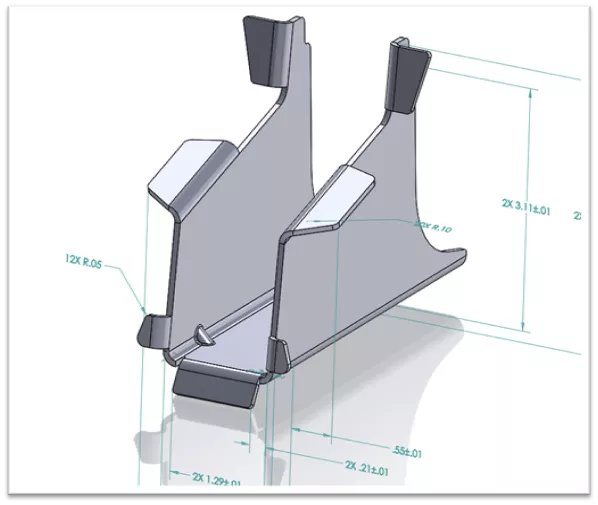
These advanced feature parameter controls are now available for:
- Break Corner
- Sheet Metal Gusset
- Swept Flange
- Miter Flange
- Sketched Bends
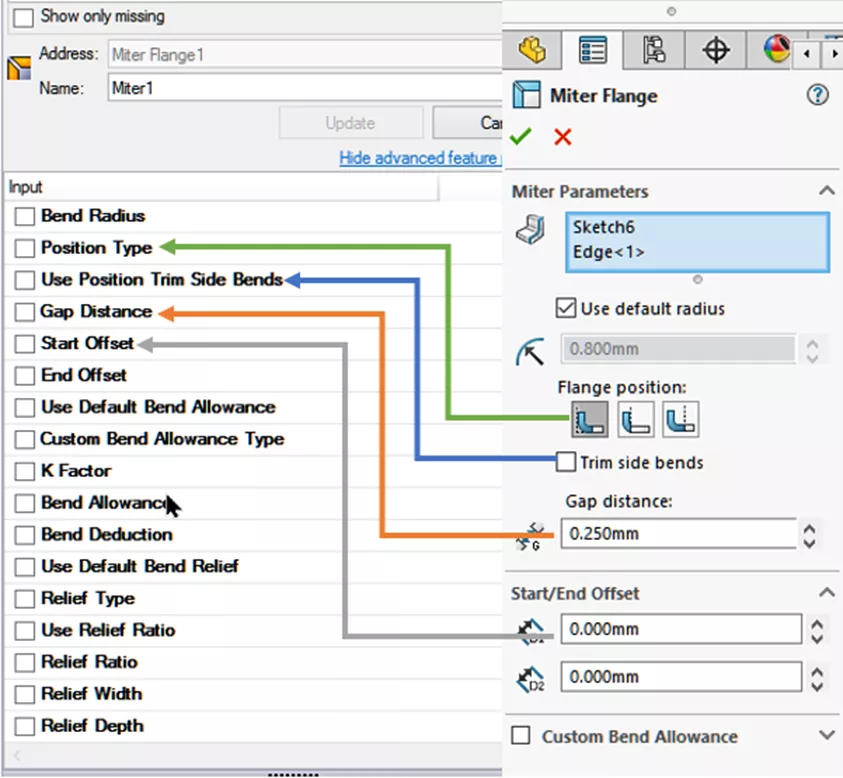
We can’t wait to see how our clients take advantage of these new advanced controls!
Sheet metal features aren’t the only features that have received development in DriveWorks 21. One of my favorite enhancements automates a complex curve feature: Curve through XYZ Points.
With Curve through XYZ Points , it is now possible to drive the table included in the feature via DriveWorks! This lets users leverage DriveWorks’ powerful table building to drive complex tables with ease.
Additionally, DriveWorks 21 allows users to drive other standard features’ advanced feature parameters, like “thin” features and slot mates.
CPQ
DriveApps provide an easy, out-of-the-box solution to manage the sales and ordering process of DriveWorks projects. In earlier releases, they weren’t as customizable. New in DriveWorks 21, users can create custom fields that are streamlined for easier use. Custom tabs can also be created to help better manage information.
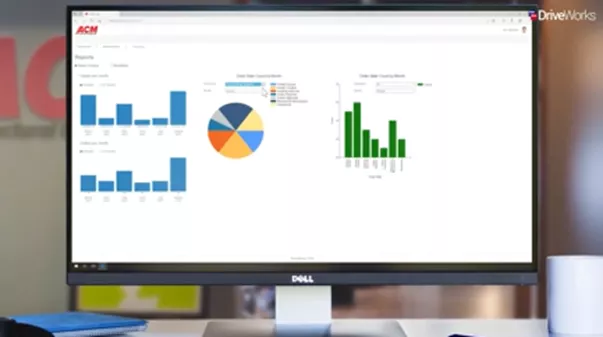
DriveApps received some performance enhancements as well. Now, users can schedule data synchronization with rules, as opposed to waiting for a response from an ERP or CRM tool. Users have data when they need it and aren't waiting for DriveWorks to fetch the requested information.
Additionally, quality-of-life enhancements give DriveWorks 21 users the ability to stay within the same specification after progressing through its workflow. It’s a subtle change, but one that comes highly requested by users to manage their specifications and close only when necessary.
Workflow
Enhancements to the DriveWorks workflow make it more intuitive for the user, requiring fewer visits to the DriveWorks Help page for more information.
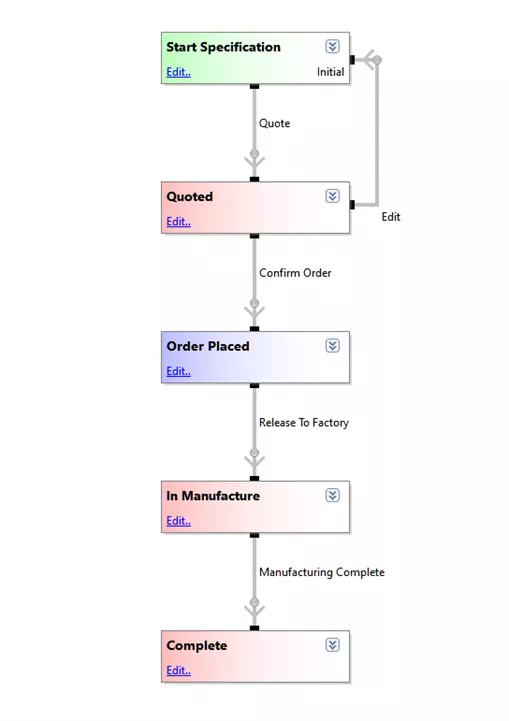
Specification macro tasks and conditions now include default properties designed to work more out of the box. These default properties clue the user in on what an acceptable and likely format for the specific macro/condition should be helping minimize any necessary debugging during project development.
Rules
In DriveWorks 21, new rules are available to write custom rules via the LAMBDA function, manage table performance, and meet modern security standards for integration.
The LAMBDA function ( introduced in Excel ) might be the most significant rule enhancement in this release. This rule provides users the ability to create custom, reusable functions where traditional DriveWorks rules aren’t appropriate. These project-specific functions are especially nice because, like all DriveWorks rules, coding knowledge isn't required in order to build custom functions. Rather, the same Excel-like syntax lets you write code with the same format you've grown accustomed to in DriveWorks 21.
Another exciting enhancement optimizes the performance of tables within DriveWorks. New rules like Columnar Range and VRefLookup grab only the necessary information required to complete the next step of specification, rather than also grabbing data that will not be used. These rules also help prevent circular references within calculation tables caused by changes to the specification.
DriveWorks 21 also includes a new security hashing option, "SHA256". This security encryption is one of the best hashing options available and is required for many mainstream ERP systems like NetSuite.
Lastly, a highlighted evaluation path is now provided in the Drill Down tab. Users can click on a function within the path Drill Down tab and the corresponding rule will be highlighted, making it even more helpful to detect and avoid errors in rule syntax.
Integration
DriveWorks can now connect with the 3D EXPERIENCE on-premise servers to manage and push/pull data to the cloud. It’s important to note that this includes only the on-premise version; it is not compatible with the on-cloud license type. The compatibility comes with several other enhancements to support those using 3D EXPERIENCE, including embedded dashboard widgets to build a single source of truth for all sales and manufacturing data. CPQ DriveApps can also be embedded to process orders through their workflow.
Also new are Specification PowerPack functions and tasks. These functions will allow web requests formatted in JSON to convert automatically to a table. Additional tasks are also available for obtaining data, like environmental variables and registry entries, that help when debugging and moving environments throughout development, testing, and production environments.
DriveWorks 21 supports Single Sign-On (SSO). SSO sends users a unique code for verification through email or mobile phone for an added layer of security. This can all be managed on a group level using DriveWorks Pro Server.
Various cloud integration enhancements have made DriveWorks 21 a must-have for users running DriveWorks on a virtual machine. DriveWorks Corp introduced rapid deployments for DriveWorks in virtual environments. These deployments load all DriveWorks modules on a VM using a “template” that can set up DriveWorks in as little as 15 minutes.
A favorite enhancement to integration is the all-new DriveWorks PowerPack for Microsoft Azure! This enhancement lets users build rules to manage MS Azure resources directly within DriveWorks. Since Azure is a SaaS model, it’s important to optimize the usage of these VMs so users only need to pay for service as needed. We love this feature because it takes the guesswork out of how Cloud licenses are being used. Currently, this is only compatible with Azure.
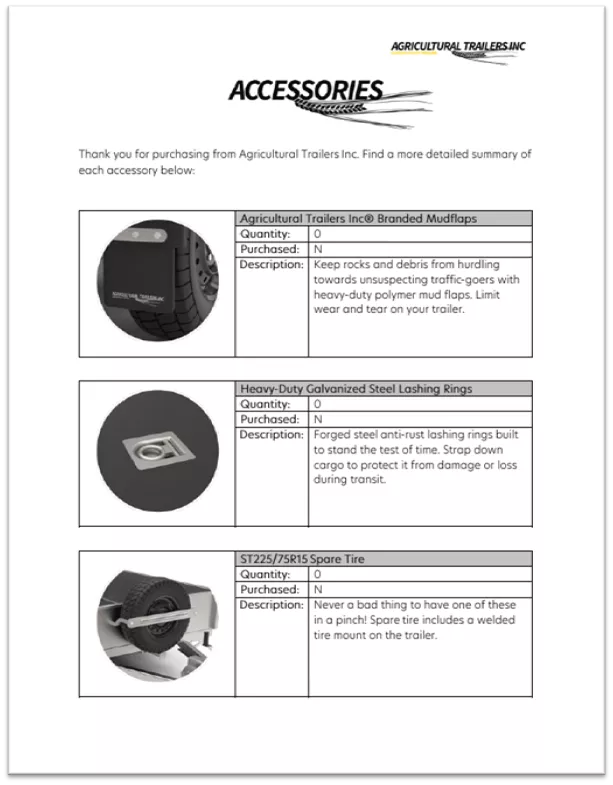
Documents
There are a few enhancements of note here. If you frequently work with Excel, you’ll notice some major benefits to the Specification PowerPack for Excel tasks. There are also some substantial changes in how users interact with PDF documents.
What's New in DriveWorks 21 with Excel?
First, new Excel PowerPack features extend the ability to add, copy, or delete Excel sheets without losing sheet formatting. If an Excel sheet is partly customer-facing, users can build rules that delete certain sheets a customer shouldn't have access to, minimizing the amount of Excel sheets you’ll need to capture in the process.
You can also export an array to a cell reference in Excel! This makes it easier to add your tabular data and embed it on cell “A1”, instead of using a named range. This is complementary to the “add sheet” feature enhancement since a sheet needs to exist to create a named range. By using cell references, we can consistently embed data that might not exist on the source document. What a great enhancement!
What's New in DriveWorks 21 with PDFs?
PDF documents are notoriously difficult to work with. Historically, to change a PDF document, one would first need to modify the source document via Microsoft Word or otherwise. Not anymore!
In the latest release of DriveWorks, users can replace text and images directly in a PDF without the need to go through a middleman! DriveWorks can also add page stamps, and modify schemes, formats, positions, and colors directly from the PDF.
Not only that, but it is also possible to create a PDF from a markdown file using CSS. These pre-formatted blocks of code make it easy for front-end web developers to create eye-catching, quality PDF documents using widely understood coding standards.
Forms
Historically, DriveWorks Live and Administrator form controls didn’t always play nicely together. Administrator controls were well built for local software usage, but when hosted through web services, they didn’t always function as intended. Additionally, the look and feel of forms could shift between environments due to the rapid improvements of modern web browsers. In recent years, web forms have come a long way, modernizing the look and feel of the web environment.
DriveWorks 21 will have form controls that can be built off CSS3 and HTML5. This single, uniform form technology will allow DriveWorks Live users to be “pixel perfect” and have high-quality images and form control, regardless of scaling.
What should you expect from this change? For starters, more customization and polish throughout your web interface. Users are no longer constrained to the size, shape, and appearance of DriveWorks default controls but can leverage popular web-based formats like CSS3 to optimize website appearances. The transition from development through Administrator to Live is seamless, meaning no more broken form controls once integrated into a company website!
Additional customization opportunities include functions such as image carousels, animations, and image filter enhancements, without requiring secondary software to provide such effects. Essentially, if you can do it on a website with HTML and CSS, the same results are possible on your DriveWorks forms.
This enhancement not only provides better web configuration but also expands the pool of resources to the majority of web developers who are familiar with CSS, making it easier to find talent to own or maintain existing DriveWorks product configurators!
3D Previews
Along with the enhancements to form controls, providing a modern look and feel to our products is a must in today’s virtual e-commerce environment. Customers are demanding more to guide them along the sales process before hitting 'buy now'. DriveWorks 21 enhancements to 3D previews help address exactly that.
Customers on active subscription will see a shift to a single web technology, optimizing how the 3D preview looks in Administrator and guaranteeing it looks the same on a web platform. 3D Preview files now support P hysically B ased R endering (PBR) materials, have improved anti-aliasing, and can glow when selected to provide visual feedback to its users.
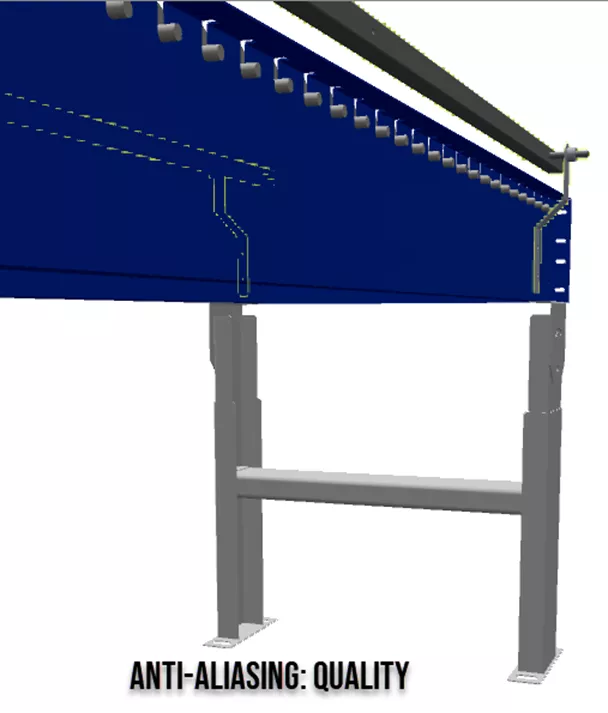
With the shift to form controls and CSS as mentioned above, 3D Previews in DriveWorks have also shifted their graphics settings to be optimized in web environments using WebGL. So, what you see in Administrator is exactly what you’ll see using DriveWorks Live.
Another favorite enhancement is the ability to apply PBR materials to Drive3D models. These materials make it easy to provide realistic model views using light, texture, and shading to capture the small details of the 3D model preview. These PBR materials also are supported when exporting .glb or .gltf files for augmented reality applications.
The improved anti-aliasing setting will make 3D models appear sharper as you roam around the 3D preview. At certain angles, it can be tough to render a straight line, causing artifacts that create staggered line edges. These edges can be more optimally controlled, with options that support anti-aliasing for performance, quality, and – a mixture of the two – balanced. Performance-based anti-aliasing trades line quality for fluid 3D navigation, whereas quality anti-aliasing will help interpret those jagged lines into smooth, crisp edges when navigating a 3D Preview.
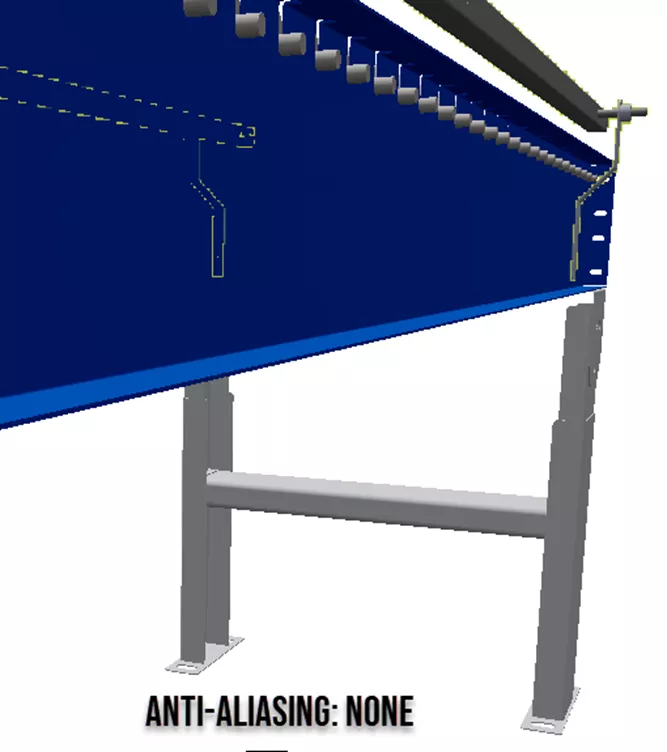
Finally, a new entity, Glow, has been added. Now, as customers configure products, 3D model geometry can be highlighted with a glow effect to indicate which part of the model is changing. Use it to highlight areas of focus in the 3D preview!
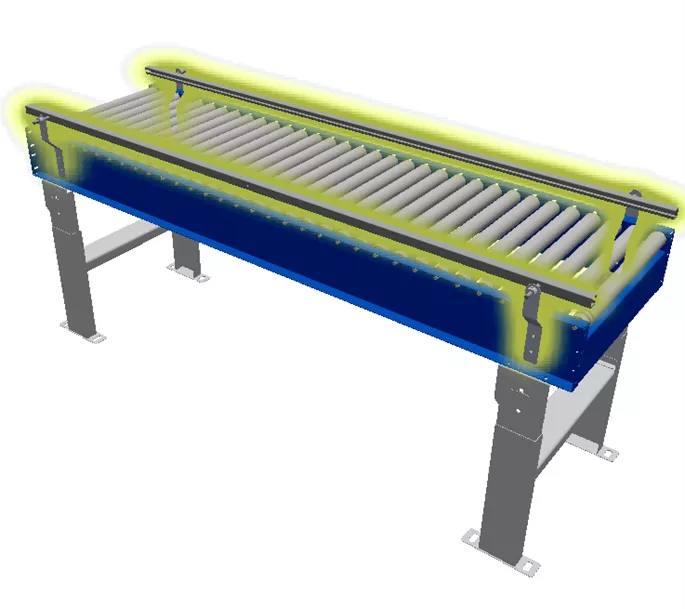
Not only did the DriveWorks development team manage to fit all these enhancements in the Drive3D model, but they managed to make it perform even better than in previous releases. After all, what good is an exceptionally realistic model if it’s clunky to navigate?
Conclusion
DriveWorks 21 is more intuitive, more cloud-ready, and more customizable than ever before. It comes loaded with default properties in specification macros and conditions users would otherwise have to dig for.
The cloud capabilities of DriveWorks 21 allow users to integrate with their on-premise 3D EXPERIENCE licenses, access data more easily and securely, and optimize the management of their virtual machines hosting DriveWorks Pro. It also comes loaded with more customization than ever before, so users can drive more advanced features, conveniently build forms using CSS3, access and customize CPQ layouts, and write custom Excel-like functions using LAMBDA.
We are excited to offer this to a wider base of clients seeking solutions to their growth via automation as we expand the limits of what’s possible under DriveWorks 21. If you are a customer who has fallen off active subscription, there is no better time to renew than with DriveWorks 21. To learn more, contact our expert sales team.
More DriveWorks Articles
Everything You Need to Know about DriveWorks Pro
Managing Configurations with DriveWorks and SOLIDWORKS
Everything You Need to Know About DriveWorks Solo
Everything You Need to Know about DriveWorksXpress

About Jordan Kleinschmidt
Jordan Kleinschmidt is a Certified SOLIDWORKS Expert, DriveWorks Professional, and Application Engineer at GoEngineer. He instructs SOLIDWORKS and DriveWorks training courses and creates educational content on design and process automation. A self-proclaimed “maker”, Jordan illustrates his creativity through various outlets such as carpentry, culinary, or painting. Jordan’s passion for manufacturing paved the way for his B.S. in Mechanical Engineering from St. Cloud State University, where he also received his B.A. in Communication Studies.
Get our wide array of technical resources delivered right to your inbox.
Unsubscribe at any time.